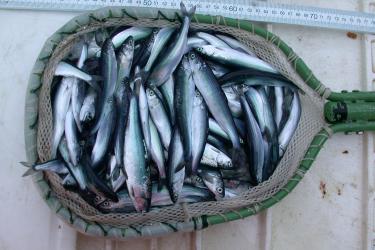
Pacific cod and northern rockfish over a mix of living substrate composed of sponge and coral.
A variety of gear types are used in these studies. Drop cameras, remotely operated vehicles (ROVs), and scuba allow scientists to identify the physical and biological characteristics of the seafloor. These observations provide insight for describing the life histories of fish and living habitat (e.g. corals and sponges). Large research vessels are used to collect high resolution sonar data to generate benthic habitat maps of important conservation areas and fishing grounds in the Gulf of Alaska and Aleutian Islands. Other research vessels are used to collect juvenile and adult fish to determine their abundance, size, and distribution. Oceanographic data, including physical characteristics of the water column, phytoplankton and zooplankton abundance, is collected to assess ecosystem processes that affect fish populations. We are always exploring new approaches and studies to describe life history characteristics and habitat requirements for important fish and invertebrate species.

Coral and juvenile rockfish from Delta submersible.
We study the Alaska seafloor to identify essential fish habitat, determine the effects of fishing on benthic habitat, improve stock assessments, and understand basic ecological processes and life histories of benthic organisms. Seafloor habitat mapping is increasingly being integrated with these long-term objectives. We use research vessels to collect high resolution bathymetry and backscatter data using multibeam sonar in several areas in the Gulf of Alaska and Aleutian Islands. We identify key fish and crab habitat and also collect valuable information on fish abundance in these areas that helps inform our estimates of total population (fish stock assessments).
In some areas, especially in the Gulf of Alaska and Aleutian Islands, an unknown proportion of the survey area is untrawlable. Since the average density of a particular fish species may differ between trawlable and untrawlable grounds, absolute abundance estimates derived from trawl surveys may be biased. Habitat mapping can help in the computation of the proportion of trawlable ground, which will aid in the calculation of unbiased abundance estimates.
Rockfish Habitat Use Studies
We conduct research at our Little Port Walter Marine Station to identify patterns of habitat use among juvenile rockfish. We evaluate the relative productivity of various benthic habitats, including habitats susceptible to disturbance from fishing gear, such as corals and sponges. We also want to assess the strength of association between juvenile rockfish and specific benthic habitat features. These assessments will aid in establishing priorities for protecting Essential Fish Habitat (EFH) for these demersal fish.
Habitat utilization patterns have been identified for young-of-the-year and age-1 quillback rockfish and work is proceeding with several species of slope rockfish. Quillback rockfish were captured in nearshore environments primarily with beach seines. Slope rockfish were captured up to 60 nautical miles offshore near the surface with an aquarium codend, a device that attaches to a surface trawl and directs fish and invertebrates into a calm water-filled chamber.



